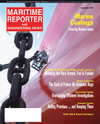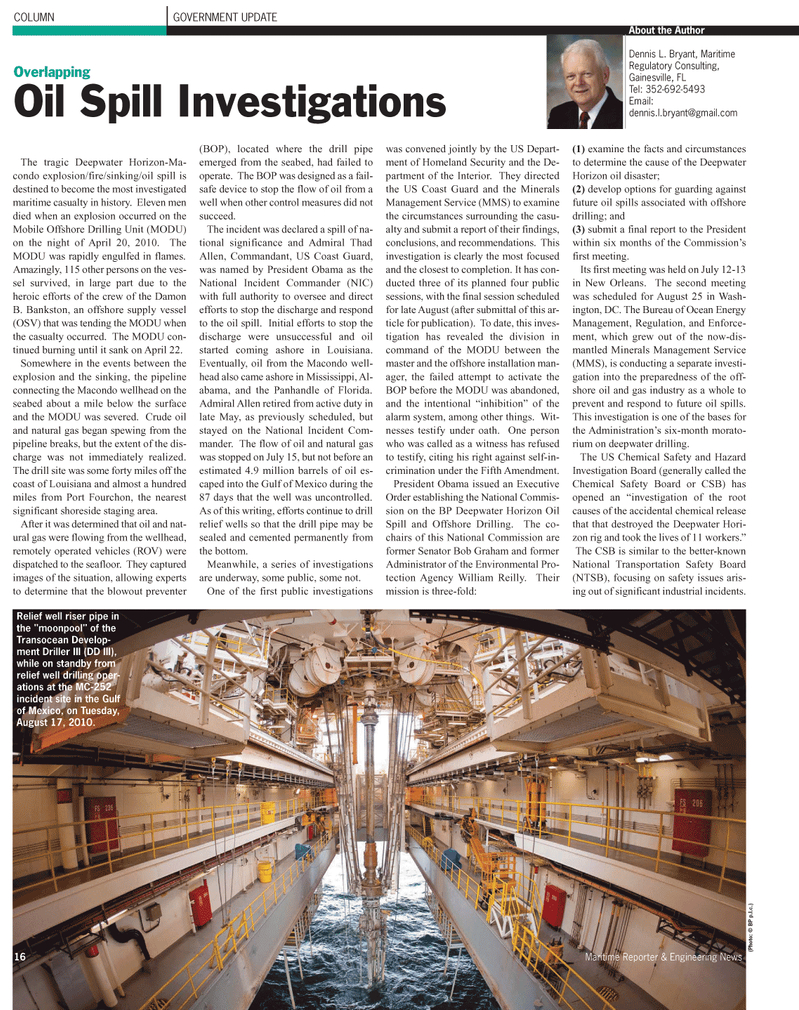
Page 16: of Maritime Reporter Magazine (September 2010)
Marine Propulsion Edition
Read this page in Pdf, Flash or Html5 edition of September 2010 Maritime Reporter Magazine
16 Maritime Reporter & Engineering News
COLUMN GOVERNMENT UPDATE
Overlapping
Oil Spill Investigations
About the Author
Dennis L. Bryant, Maritime
Regulatory Consulting,
Gainesville, FL
Tel: 352-692-5493
Email: [email protected]
The tragic Deepwater Horizon-Ma- condo explosion/fire/sinking/oil spill is destined to become the most investigated maritime casualty in history. Eleven men died when an explosion occurred on the
Mobile Offshore Drilling Unit (MODU) on the night of April 20, 2010. The
MODU was rapidly engulfed in flames.
Amazingly, 115 other persons on the ves- sel survived, in large part due to the heroic efforts of the crew of the Damon
B. Bankston, an offshore supply vessel (OSV) that was tending the MODU when the casualty occurred. The MODU con- tinued burning until it sank on April 22.
Somewhere in the events between the explosion and the sinking, the pipeline connecting the Macondo wellhead on the seabed about a mile below the surface and the MODU was severed. Crude oil and natural gas began spewing from the pipeline breaks, but the extent of the dis- charge was not immediately realized.
The drill site was some forty miles off the coast of Louisiana and almost a hundred miles from Port Fourchon, the nearest significant shoreside staging area.
After it was determined that oil and nat- ural gas were flowing from the wellhead, remotely operated vehicles (ROV) were dispatched to the seafloor. They captured images of the situation, allowing experts to determine that the blowout preventer (BOP), located where the drill pipe emerged from the seabed, had failed to operate. The BOP was designed as a fail- safe device to stop the flow of oil from a well when other control measures did not succeed.
The incident was declared a spill of na- tional significance and Admiral Thad
Allen, Commandant, US Coast Guard, was named by President Obama as the
National Incident Commander (NIC) with full authority to oversee and direct efforts to stop the discharge and respond to the oil spill. Initial efforts to stop the discharge were unsuccessful and oil started coming ashore in Louisiana.
Eventually, oil from the Macondo well- head also came ashore in Mississippi, Al- abama, and the Panhandle of Florida.
Admiral Allen retired from active duty in late May, as previously scheduled, but stayed on the National Incident Com- mander. The flow of oil and natural gas was stopped on July 15, but not before an estimated 4.9 million barrels of oil es- caped into the Gulf of Mexico during the 87 days that the well was uncontrolled.
As of this writing, efforts continue to drill relief wells so that the drill pipe may be sealed and cemented permanently from the bottom.
Meanwhile, a series of investigations are underway, some public, some not.
One of the first public investigations was convened jointly by the US Depart- ment of Homeland Security and the De- partment of the Interior. They directed the US Coast Guard and the Minerals
Management Service (MMS) to examine the circumstances surrounding the casu- alty and submit a report of their findings, conclusions, and recommendations. This investigation is clearly the most focused and the closest to completion. It has con- ducted three of its planned four public sessions, with the final session scheduled for late August (after submittal of this ar- ticle for publication). To date, this inves- tigation has revealed the division in command of the MODU between the master and the offshore installation man- ager, the failed attempt to activate the
BOP before the MODU was abandoned, and the intentional “inhibition” of the alarm system, among other things. Wit- nesses testify under oath. One person who was called as a witness has refused to testify, citing his right against self-in- crimination under the Fifth Amendment.
President Obama issued an Executive
Order establishing the National Commis- sion on the BP Deepwater Horizon Oil
Spill and Offshore Drilling. The co- chairs of this National Commission are former Senator Bob Graham and former
Administrator of the Environmental Pro- tection Agency William Reilly. Their mission is three-fold: (1) examine the facts and circumstances to determine the cause of the Deepwater
Horizon oil disaster; (2) develop options for guarding against future oil spills associated with offshore drilling; and (3) submit a final report to the President within six months of the Commission’s first meeting.
Its first meeting was held on July 12-13 in New Orleans. The second meeting was scheduled for August 25 in Wash- ington, DC. The Bureau of Ocean Energy
Management, Regulation, and Enforce- ment, which grew out of the now-dis- mantled Minerals Management Service (MMS), is conducting a separate investi- gation into the preparedness of the off- shore oil and gas industry as a whole to prevent and respond to future oil spills.
This investigation is one of the bases for the Administration’s six-month morato- rium on deepwater drilling.
The US Chemical Safety and Hazard
Investigation Board (generally called the
Chemical Safety Board or CSB) has opened an “investigation of the root causes of the accidental chemical release that that destroyed the Deepwater Hori- zon rig and took the lives of 11 workers.”
The CSB is similar to the better-known
National Transportation Safety Board (NTSB), focusing on safety issues aris- ing out of significant industrial incidents.
Relief well riser pipe in the "moonpool" of the
Transocean Develop- ment Driller III (DD III), while on standby from relief well drilling oper- ations at the MC-252 incident site in the Gulf of Mexico, on Tuesday,
August 17, 2010. (Photo: © BP p.l.c.)

 15
15

 17
17
